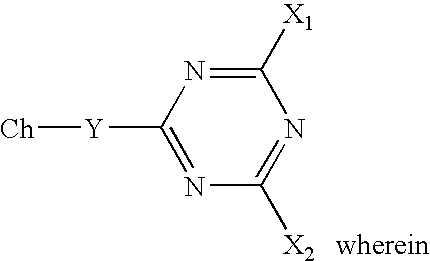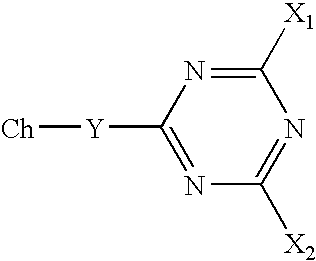Method of dyeing a substrate with a reactive dyestuff in supercritical or near supercritical carbon dioxide
a technology of supercritical or near supercritical carbon dioxide and dyeing method, which is applied in the direction of organic dyes, chemistry apparatus and processes, textiles and paper, etc., can solve the problems of insufficient satisfactory supercritical dyeing methods described in the prior art, large amount of dyeing, waste water, etc., and achieve enhanced reactivity of reactive dyestuffs, excellent fixation, and good results
- Summary
- Abstract
- Description
- Claims
- Application Information
AI Technical Summary
Benefits of technology
Problems solved by technology
Method used
Image
Examples
example 1
[0047]A piece of 0.25 g of mercerized cotton was pre-treated in a fluid medium consisting of 20 g of methanol as hydrogen bond acceptor. The pre-treatment was carried out at 40° C. and 1 bar by immersing the cotton in the methanol and gently shaking for 12 h. The pre-treated cotton was removed from the fluid medium and transferred as such for dyeing treatment. The remaining methanol in the cotton after the pre-treatment was about 60% by weight of the cotton substrate The dyeing test was carried out in a high-pressure batch reactor designed to carry out experiments under supercritical conditions. The reactor consisted of a 150 mL pressure vessel provided with a pressure manometer and a needle valve.
[0048]The piece of pre-treated cotton was placed into the batch reactor together with the reactive disperse dye (6-fluoro-N-[4-(phenyldiazenyl)phenyl]-1,3,5-triazine-2,4-diamine), a co-solvent and an acid. The amount of dye used was 10% by weight of the fibre (owf). The applied co-solvent ...
example 2
[0052]The experimental procedure described in example 1 was applied to 0.25 g of mercerized cotton. In this experiment the acid was CH3COOH in a concentration of 4545 mol% calculated on the molar amount of the reactive dye substance, so the requirement, K.C≧0.03, is fulfilled.
[0053]The result after 4 h dyeing was a yellow piece of cotton that was evenly dyed.
The K / S value after dyeing was 17.5 and K / S after extraction was 17.3, corresponding to an excellent fixation of 98%.
example 3
[0054]The experimental procedure described in example 1 was applied to 0.25 g of mercerized cotton. In this experiment the dye used was (4-fluoro-6-methoxy-N-[4-(phenyldiazenyl)phenyl]-1,3,5-triazin-2-amine) and H3PO4 was the acid at a concentration of 10% mol calculated on the molar amount of reactive dye substance, so the requirement, K.C≧0.03, is fulfilled
[0055]The result after 4 h dyeing was a yellow piece of cotton that was evenly dyed.
The K / S value after dyeing was 17.8 and K / S after extraction was 14.5.
PUM
| Property | Measurement | Unit |
|---|---|---|
| critical pressure | aaaaa | aaaaa |
| temperature | aaaaa | aaaaa |
| pressure | aaaaa | aaaaa |
Abstract
Description
Claims
Application Information
 Login to View More
Login to View More - R&D
- Intellectual Property
- Life Sciences
- Materials
- Tech Scout
- Unparalleled Data Quality
- Higher Quality Content
- 60% Fewer Hallucinations
Browse by: Latest US Patents, China's latest patents, Technical Efficacy Thesaurus, Application Domain, Technology Topic, Popular Technical Reports.
© 2025 PatSnap. All rights reserved.Legal|Privacy policy|Modern Slavery Act Transparency Statement|Sitemap|About US| Contact US: help@patsnap.com


